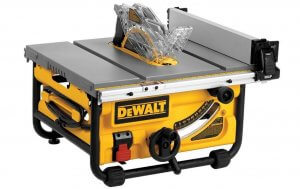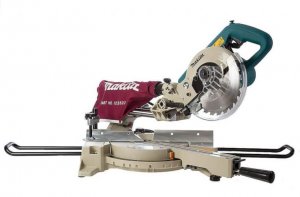In a world where you had an unlimited budget and infinite space, you’d probably love to have both a table saw and a miter saw. After all, the more tools, the better, right?
The reality is that you might not have the budget or room for two types of saws. And even if you did, do you really need both?
In this guide, we’ll describe each type of saw, discuss their differences and give you objective advice on when you should use each of these tools.
By the end of this article, you’ll have a better idea of what saw best suits your needs if you’re on the fence (pun intended).
What is a Table Saw?
Table saws are considered one of the most versatile woodworking tools, and they’re found in most workshops. The differentiating characteristic of a table saw is that it has a circular blade built into a flat tabletop surface. There will be a motor underneath the table or attached to the side, which powers the blade.
There are different types of table saw, however the most popular tends be the portable / jobsite saw. No matter what brand table saw you get and no matter how much you pay for it, this overall structure remains a constant.
To operate a table saw, the woodworker must push the material across the table and into the blade to make the cut. They’re designed mostly for cutting through larger pieces of lumber quickly, though there are models that can be used for more intricate work as well. By adding a miter gauge to a table saw, this piece of equipment becomes even more of a versatile powerhouse for a workshop.
Table Saw Uses
There’s not much a table saw can’t handle. Its capabilities include:
- Ripping lumber
- Performing cross cuts
- Furniture and cabinet builds
- Doing miter cuts
- Making rabbet joints (with a dado blade)
- Doing dado cuts and grooves (with a dado blade)
- Applying shapes and custom edges to wood
In general, table saws are used for working with larger pieces of lumber, though the table saw’s versatility means that you can also use it for more detailed work, too. If you ask woodworkers what the single most useful and versatile tool they have in their shop is, most will tell you without hesitation that it’s their table saw.
Table saws excel at helping woodworkers of all skill levels quickly and accurately machine materials without a lot of fussing or making endless adjustments.
What is a Miter Saw?
A miter saw is a more specialized piece of equipment, and it’s often the first semi-stationary tool that new woodworkers purchase. This type of saw is meant for detailed work like frames and crown molding. Unlike a table saw that has the blade built into the table’s surface, a miter saw’s blade is mounted on an arm, called a “swing.”
Rather than pushing the wood across the table as one would do with a table saw, miter saw operators keep the wood stationary and position the blade where they want it to cut the material. This means that the length of your cut will be limited to the diameter of your blade.
With a miter saw it’s easier (and faster) to make repeated cuts that are all the same length. You can also get accurately cut miters, aka angles.
The way they are designed means they are portable and can be moved around relatively easy. There is also specialized miter saw stands that are available to buy which can be used on the go.
Miter Saw Uses
Miter saws are an essential carpentry tool for achieving accurate cuts. You may not get as much regular use out of a miter saw as its applications tend to be more specific and limited, but these saws can be a huge time saver if you’re creating hours of cuts for a project.
Though table saws are typically best for ripping long boards, miter saws should be a top pick if you’re crosscutting them. Miter saws shine when it comes to creating frames, casings and crown molding. Because the board remains stationary when using a miter saw, the length of the cut is limited to the diameter of the blade. This means that miter saws are typically limited to cross-cutting, which is cutting a board to length across the grain.
Although a table saw can also technically perform this particular task, a miter saw will do it much more quickly.
Table Saw vs. Miter Saw: The Differences Explained
The biggest difference is in the structure of the two tools.
With a table saw, the stock moves against the rotating blade and is pushed through by the operator. By contrast, when using a miter saw, the operator holds the wood in place, and the blade head moves from the top down to make the cut. These different methodologies allow each piece of equipment to function differently with the width of materials they can accommodate and the types of cuts they can make.
Overall, table saws are more versatile, since they can do virtually anything a miter saw can do, though with arguably less precision. Hardcore table saw enthusiasts would argue that they don’t need a miter saw. They can do all the same work with sleds, miter gauges, and custom fences. Miter saw diehards are quick to point out that the repeatability of precision cuts can be extremely challenging to duplicate quickly and efficiently.
While both tools require precaution and safe handling, table saws are the more dangerous of the two (see these table saw safety tips). They also tend to be heavier and take up more space in a workshop or on a job site.
A table saw has the distinct advantage of being able to handle longer cuts and rip boards, while also being able to do smaller cut jobs. One potential disadvantage is that it won’t have the precision of a miter saw and may require purchasing special equipment like a miter gauge or building a sacrificial fence to handle precision work.
Miter saws can do more cuts but limited in the size of boards they can cut. The maximum diameter is a 6” cut for a 10” saw, and, at most, an 8” cut for a 12” saw. Miter saws tend to be more portable than even the lightest table saws, and they are now cordless models available too. If you tend to move between job sites, then having a miter saw can make being on the go less of a hassle.
Depending on the brand, type of table saw and the feature set, there can be a significant price difference between a table saw and a miter saw. If you are looking at portable or semi-portable table saws, then the pricing will be about the same. At that point, it comes down to the type of jobs you’re doing since the cost differences between the two pieces of equipment are likely to be negligible.
When to Use Table Saws
Table saws can be used for just about anything, but their most common use is for ripping long boards or doing general purpose cutting. They’re a woodworker’s most important helper.
Though they can cut through almost anything you give them, precision may be an issue. If you’re not overly concerned with accuracy and you’ve got a large volume of work to get through, a table saw is likely your best option.
Your purpose and job types will also help you decide if using a table saw is your best option. If you’re doing jobs related to home remodeling, building furniture or general handiwork, you’ll most likely need a table saw to handle those functions.
Though you can also obtain precision cuts with a table saw, it often requires extra work. You may need to create custom fences and sleds to use to duplicate a cut, and you may find that you need to recalibrate your saw. And, despite your most careful calculations and measurements, there’s bound to be mistakes and a margin of error. Plus, all of this takes time and extra effort, so it’s worth weighing the cost and benefit of owning a miter saw in addition to a table saw if you need to do both general purpose and precision work.
When to Use Miter Saws
Miter saws are meant for smaller cuts and more specialized tasks. If you need precision and accuracy, opt for a miter saw. Here are some of the scenarios for miter saws:
- When you’re looking to do a series of small, precision cuts
- Carpentry work
- You need a specialty tool for trimming around door casings or base trim
- You’re making frames for doors, pictures or windows
- You are producing crown moldings or window casings
- You want to quickly crosscut long boards
- You need to make bevel cuts
- You’re building smaller items like bird feeders, curio shelves, etc.
- Can be used at a job site for general cutting of 2x4s and, in some cases, 2x6s
Miter saws are also ideal for complex projects like building decks, though you may still need a table saw for larger wood pieces. If you’re a carpenter, you’ll also want to consider owning a miter saw as you’ll likely need accurate equipment for window and door frames, trims, moldings, and other intricate work.
Conclusion
A case can certainly be made for purchasing both types of saws. If you’re an avid woodworker, and either a tradesman or serious DIYer, you’ll probably benefit from having specialized tools for each of your tasks.
However, if you’re looking to get started with something quickly and you want versatility, consider starting with a table saw that has a decent miter gauge. If the table saw that’s on the top of your list doesn’t come with a miter gauge or the one it has is subpar, then you can opt to purchase one separately.


Reader Interactions